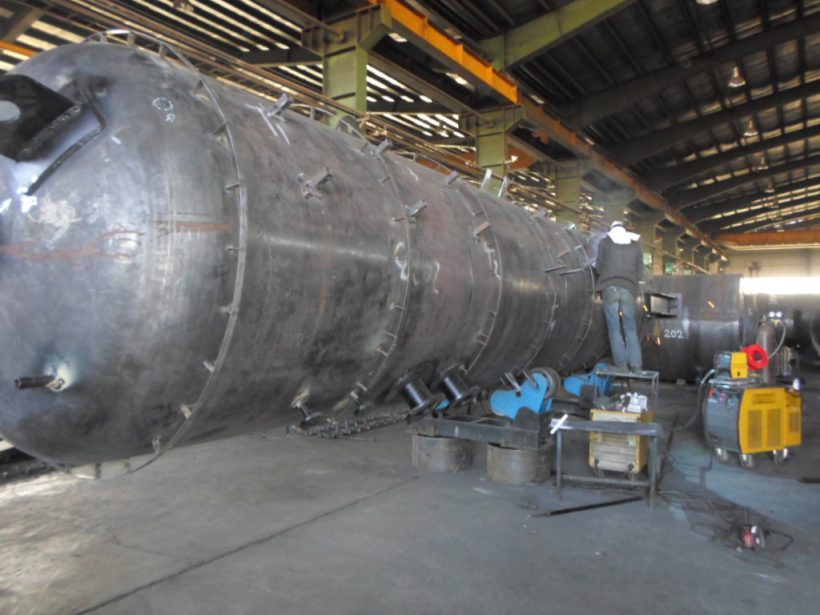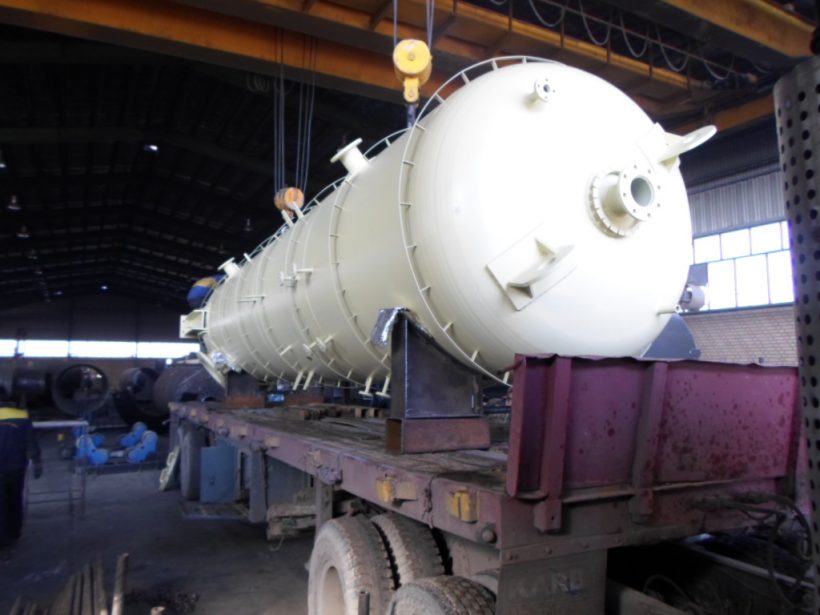Accumulator
ACCUMULATOR
As a result, their fixed and current costs increase and sometimes suffer great loss, but what is the solution? Is the storage of steam needs a compartment like hot water? Can steam be stored in a chamber without a proper insulation for a longer time? Does steam not condensed in a long time?

دستگاه ذخیره ساز بخار
There are many questions. First, we mention some common types of storage in the industry examples and then discuss saving steam and thermodynamic calculations of it.
Several storage cases and their benefits:
Usually peak of water use is 2.5 times the normal time of consumption. We assume that a city of one thousand people with 240 liters consumption for each person uses 1000 cubic meters an hour. At peak hours, it will reach 2,500 cubic meters. If we establish facilities on the basis of 2,500 cubic meters per hour, its cost will be very high. The same city during the hours of midnight does not have even 10% of normal hour’s consumption, and water storage becomes important here. At night storage tanks are filled and in the peak hours of the day they are used.


Saving energy as hot water in large residential complexes for is obvious for those involved. Hot water storage tank has a decisive role in reducing the powerhouse boiler capacity. Storing is not just in form of heat. Chiller of cooling, when there is no need to reduce the temperature in the building, slowly produces ice and stores it in some chambers. When the ambient temperature is high, the melting of the ice helps to reduce the capacity of the chiller.
The above examples all show the benefits of storage in the industry, but how is vapor deposition?
ذخیره بخار
Steam deposition:
Lets assume a consumer such as autoclaved lightweight concrete ACC, rubber curing presses, or plastofoam uses 10000 kg steam for ten minutes. If put away all engineering pre-assumptions, the boiler we must buy to produce 1000 kg of steam in 10 minutes has a capacity of 6000 kilograms per hour. If there is a device that can store up steam, so that in the required 10 minutes gives 1000 kg of steam along with the boiler to the systems, we can buy a boiler with a capacity of 1000 kg. By a simple calculation, we see a boiler with a capacity of 1000 kg per hour generates 167 kg steam within 10 minutes and in fifty minutes later 834 kg. If during this 50 minutes, it gives its steam to a save system, at last 10 minutes, it can store and give a total of 1000 kg steam with the boiler to the user. Now, if the reader compares boiler price of 6000 kg per hour that is about 650 million riyals boiler with a boiler of 1000 kg per hour capacity that is about 250 million riyals, he will realize the storage can be valuable in the plant economy.
Today, boilers in similar size and capacity compared to 40 to 50 years ago are much smaller and more compact sized, the reasons for reduction of volume include:
progress in construction technology
The existence of new steels that are more tolerant of heat flux
The existence of extensive research and laboratories in heat transfer
And the most important, the development of new industrial burners that have greatly increased the efficiency of fuel burning.
These developments have led to a decrease in volume of boilers but have caused boilers to be sensitive to fluctuations in consumption, and with momentary increase in consumption, alarms go off and risks are identified and thus the burner goes off.
The following table shows decrease of volume of modern boilers compared to boilers 30 years ago.
Suppose there is conventional steam boiler with a diameter of 2200 mm and height of 800 mm and a useful length of pond of boiler steam atmosphere as 4000 mm, the amount of heat stored is:
X = H/D X = 800/2200 = 0.3636
With having the X amount from the tables of half full layers of half-full surfaces compared to full levels, it is A / At = 0.324.
The cross section of the vapor space: × 0.324 = 1.23 m² π ²1.1
Steam space volume:
³ 4 × 1.23 = 4.29 m
If the boiler works at a pressure of 10 absolute atmospheres, in accordance with thermodynamic table, eigenvolume is equal to 0.19444 cubic meters per kg. If the above volume is divided by the eigenvolume, 25.3 kg of steam will be saved. As you can see, this is a very low steam deposition.
Many consumers ask the question: is it possible to consider a storage tank steam like for hot water or water or not? We assume that a tank working pressure of 10 atmospheres and dimensions of the steam boiler to save like the example above, the amount of steam that is stored in this system is:
15.2/0.19444=78.2
Now the question arises: how should we save heat?
Accumulator is device that stores steam in water in the form of “internal energy” and usually to store steam there should be a pressure difference between the boiler and the consumer.
Accumulator is storage tank that 50% to 90% of its volume is filled with water. Controller determines the level of this volume. It is used horizontally and vertically. Powerhouse that has appropriate height is better to be vertical, otherwise it is used horizontally.
(Water in accumulator is heated by steam boilers and steam energy is stored in the form of “internal energy” in the pressure the same as the boiler pressure). When the consumer has steam consumption, in parallel with boiler, it uses its internal energy and gives it to the consumer in the form of steam that helped to reduce the capacity of the boiler. The existence of accumulator somehow stops fluctuations in the feeding of steam and keeps it at a constant level.
Accumulator storage capacity computation is as follows.
We assume that we have the storage tank above filled to a height of 1400 mm with water, and then we calculate volume or mass inside it.
× 1000/4 = 15205 lit × 4 π ²2.2
15205 – 4920 = 10285 lit
The eigenweight of water at 20 ° C is:
(@ 20) = 998 kgρ
Mass of water in the tank is equal to:
m = 10285 × 998/1000 = 10264 kg
Boiler gives its steam to the accumulator up to 10 atmospheres and is heated by sprays of water steam. The water inside first reaches 100 degrees temperature. Then it begins to evaporate and the space above the tank is filled with steam to reach the previous regulated pressure. Let’s see how much energy is stored in the accumulator.
Water energy at the beginning:
(Water temperature is assumed 20 degrees initially) Q = mCT = 10264 × 4.2 × 20 = 862176 kj
The energy of the water in the end that is 180 ° C and 10 atm
QF = mCT + m Sl. hg
(In the example above, hg is enthalpy of steam at a temperature of 180 ° C.)
(Water thermodynamic tables hg = 2778.1 kj / kg vacuum pressure of 10 atm)
QF = 10264 × 4.2 × 180 + 78 × 2778.1 kj / kg = 7976276 kj
The change is the beginning and end is:
ΔQ = QF – Q = 7976276 – 1274616 = 711411 Kj
The mass of steam absorbed to reach the final state can be calculated that is given to accumulator by the boiler.
ms = ΔQ / hfg = 7114100/2015 = 3530 kg
Hfg is the latent heat of vaporization at 180 ° C.
Second stage: the energy in the accumulator when its total energy opens at 1 atmosphere pressure
First, we calculate the energy inside the accumulator.
Hg(@1atm 100 ċ ) = 2675.5 kj/kg
QF ( @ 1 atm , 100 ċ ) = 10264 ×4.2×100 = 4310880
m(@ 1 atm 100 ċ ) = 4.92/1.6940=2.9 kg
The steam supply for a consumer use at one atmosphere pressure is:
Qtot ( @ 1atm ,100ċ)= Qf + mhg = 4310880+280 ×2778 = 4381190 kj
ms=ΔQ / hfg
If we estimate this difference at 4 atmospheres:
ms=(@ 4 atm ) = 1166 kg
Finally, to 8 atmospheres
ms(@8atm) = 3630 kg
Implementation process:
As seen in Figure 3, the steam is injected from the boiler into the water in accumulator. After the temperature and pressure of the boiler reached pressure and temperature of the boiler, both devices remain in balance so that the consumer valve is opened, and both the boiler and accumulator feed the system in parallel. Note that, the pressure reducing valve must be in line unless the consumer operates at atmospheric pressure.
Device selection:
If accumulator capacity is not selected properly, it causes disruption in the system. If water inside is too much, the heat that it absorbs equals the boiler capacity and the consumer must wait until the storage reaches a saturation point. This means stop in work, so in such times it is better to empty some of the water in the accumulator, and if we do not select the right accumulator capacity, the accumulator itself as an in line consumer increases steam consumption.

